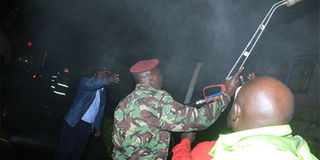Poor response by firefighters causing massive losses

A police officer helps firefighters put out a fire after it broke out at St George's Girls School, Nairobi. Firefighters have been put on the spot over their slow response which results in massive losses. PHOTO | JEFF ANGOTE | NATION MEDIA GROUP
What you need to know:
According to Mr Brian Kisali, the chief fire officer in Nairobi, the department receives at least five cases of fires in a day.
He says the department is also understaffed, with efforts to remedy the situation still unsuccessful.
Meanwhile, in Mombasa, failure by firefighters to quickly respond to fires has caused loss of property worth millions of shillings.
Saturday, September 2, 2017, will forever be etched in the memories of many.
Kenyans woke up to the sad news of the deaths of nine Moi Girls School students after their dormitory caught fire.
Even though the blaze started at 2am, it was not until an hour later that firefighters from the Nairobi county government arrived at the scene and extinguished the fire, raising questions as to why they took so long to respond.
The city has also witnessed more than six other fire incidents recently — including one at a nightclub owned by Governor Mike Sonko in Buruburu estate, one at St George’s Girls School as well as another one in Gikomba market.
FIVE CASES
According to Mr Brian Kisali, the chief fire officer in Nairobi, the department receives at least five cases of fires in a day.
“We have, however, tried our level best to contain them,” he says.
City Hall has at least 50 fire engines acquired from Japan and Belgium.
Mr Kisali says they have received 18 more fire engines from Belgium. “They are at the Mombasa port awaiting clearance.”
He added the Belgium government is also constructing a fire station at the Inspectorate school in Dagoretti.
FIRE STATIONS
The World Bank, on the other hand, is constructing two other fire stations in Waithaka and at the East Africa Breweries.
On the time it takes the firefighters to reach fire scenes, the official points out that it depends on various factors including the time the incident occurred and the level of traffic.
“It is obvious that at night, our response time is usually shorter because there is less traffic,” he says.
He says the department is also understaffed, with efforts to remedy the situation still unsuccessful.
The county had indicated that it intended to employ at least 100 firefighters. It is still unclear how far the process has reached.
PROPERTY LOSS
Meanwhile, in Mombasa, failure by firefighters to quickly respond to fires has caused loss of property worth millions of shillings.
On August 8, a huge fire broke out at the Mbaraki Bulk Terminal Ltd, destroying property of unknown value.
During the incident, county fire engines arrived exactly 45 minutes after fuel tankers burst into flames, injuring three people.
By that time, the huge blaze had already spread to various areas destroying property worth millions of shillings.
Two months earlier, a building caught fire in Ganjoni, destroying the ground floor and several adjacent buildings. The county fire engines arrived more than half an hour after the inferno started.
Mombasa County, through its spokesman Richard Chacha, attributed delays to narrow access roads in most neighbourhoods and ineffective alerts.
“Our fire engines have, most of the time, been unable to manoeuvre the narrow access roads in some of our estates. In addition, if people do not alert our fire fighting personnel fast enough, they will not be able to respond on time,” added Mr Chacha.






